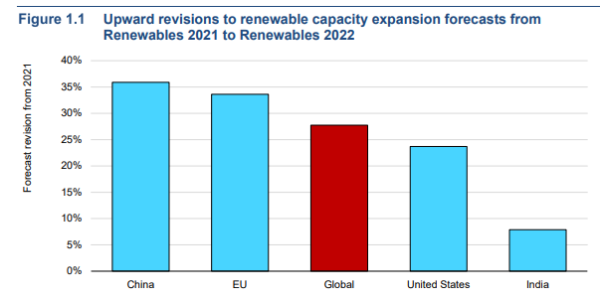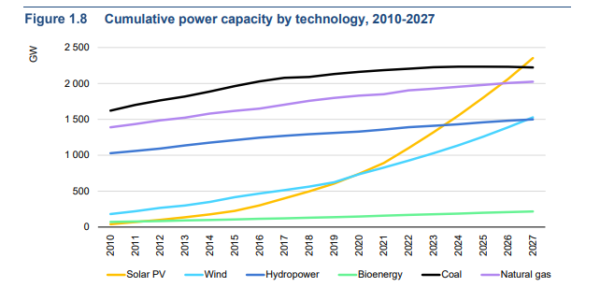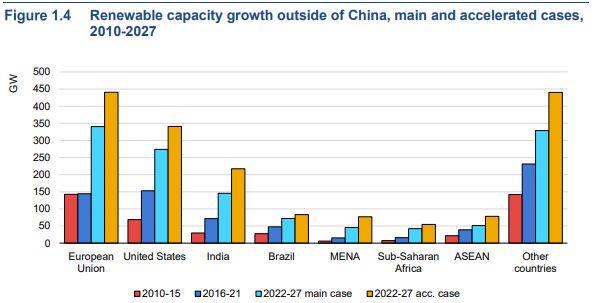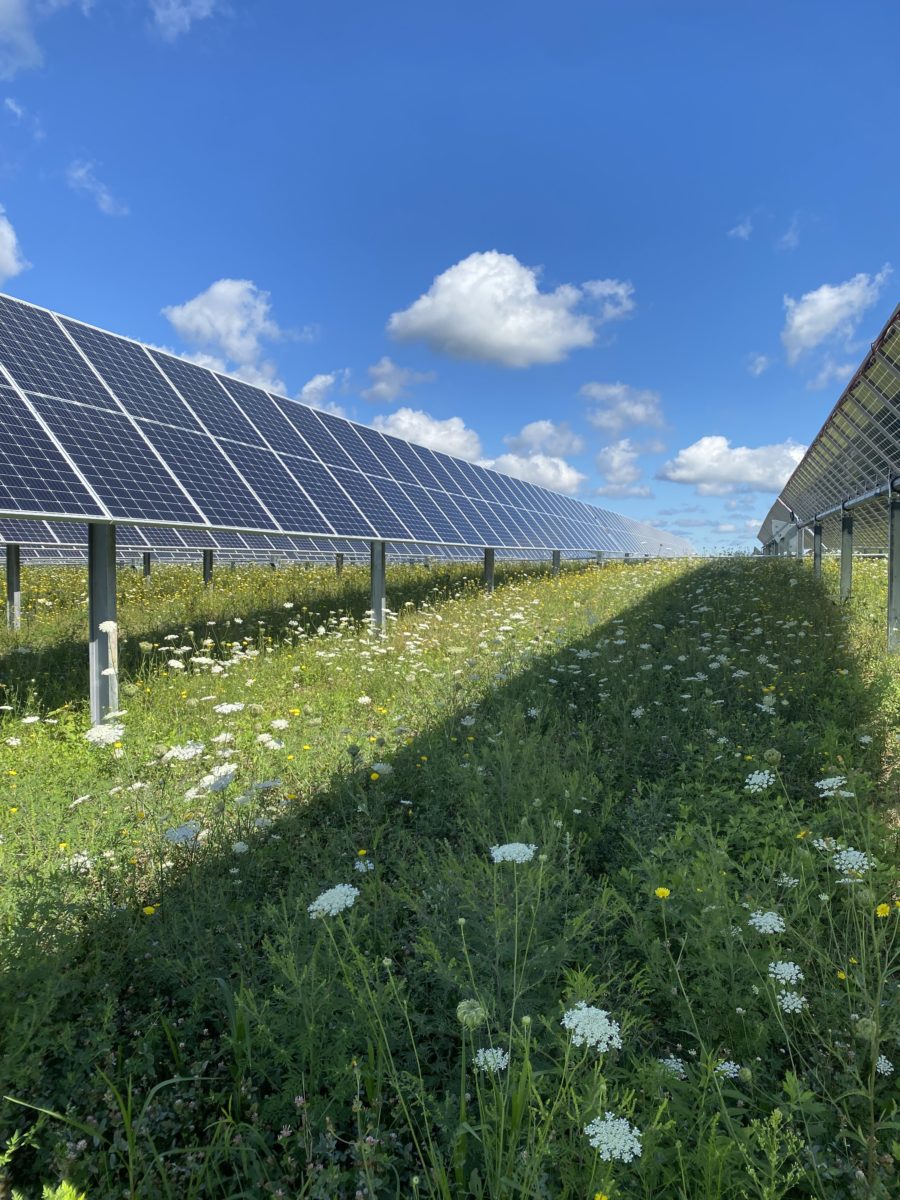Solar, wind and other renewable energy sources are expected to continue building momentum, increasing installed capacity by 75% through 2027, said the International Energy Agency (IEA). The growth in deployment would represent as much capacity added in the next five years as the last 20, adding about 2,400 GW over the period.
The IEA report said that renewable energy expansion is 90% of the planned additions worldwide, and 90% of that number will be represented by solar and wind energy. Cumulative solar PV capacity almost triples in the IEA forecast, growing by almost 1,500 GW over the period, exceeding natural gas by 2026 and coal by 2027.
“Renewables were already expanding quickly, but the global energy crisis has kicked them into an extraordinary new phase of even faster growth,” said Fatih Birol, executive director, IEA.
In five years, global renewable capacity would represent an amount equal to the total installed power capacity of China, said the report. The growth projections are 30% more than was expected last year.

IEA said two major drivers for global renewable energy adoption are low prices and security.
“First, high fossil fuel and electricity prices resulting from the global energy crisis have made renewable power technologies much more economically attractive, and second, Russia’s invasion of Ukraine has caused fossil fuel importers, especially in Europe, to increasingly value the energy security benefits of renewable energy,” said the report.
“This is a clear example of how the current energy crisis can be a historic turning point towards a cleaner and more secure energy system. Renewables’ continued acceleration is critical to help keep the door open to limiting global warming to 1.5 °C,” said Birol. Limiting global warming to this level is key to staving off the worst effects of climate change.
Solar PV on its own accounts for over 60% of all forecast renewable capacity expansion, setting records for annual additions every year through 2027. Although module prices have increased, utility-scale solar PV is the least costly option for new electricity generation in a significant majority of countries worldwide.

Commercial and residential solar PV systems make up 26% of the global renewable capacity additions forecast for the next five years, and the outlook for distributed solar PV applications has been revised upwards due to high natural gas prices raising retail electricity bills.
Competitive auctions remain the main driver of forecast growth, with increasing contributions from corporate power purchase agreements, bilateral contracts and merchant activity. Through nine months 2022, about 77 GW of new renewable auction capacity was awarded globally, mostly solar and wind projects. This is a 70% increase from the same period in 2021, with China and Europe accounting for three-quarters of total awarded capacity.
Elevated commodity prices, high freight costs and ongoing supply chain disruptions have caused onshore wind investment costs to increase by 15-25% and solar by 10-20% from pre-Covid levels, reversing a decade-long declining trend in prices.
Through the first nine months of 2022, the price of solar-grade polysilicon almost quadrupled, aluminum more than doubled, copper rose by 90%, steel by 40%, and freight fees rose fourfold.
Renewable energy capacity in the United States is forecast to increase 74%, or over 280 GW from 2022 to 2027. This year’s forecast was revised upward by 25% from last year’s following the passage of the Inflation Reduction Act (IRA) of 2022.
IRA incentives are expected to support the Biden Administration target of 100% carbon-pollution-free electricity by 2035. In addition, 37 out of 50 states have renewable portfolio standards and goals supporting expansion. Now that the country has clear long-term policy visibility, uncertainties in the U.S. renewable electricity buildout are due to project delays related to supply chain constraints, trade measures, the availability of grid infrastructure and long permitting timelines.
IEA said renewable energy buildout may have to accelerate even faster to meet increased demand due to electrification of transport, heating and cooling, and more. It laid out a scenario where renewables add 25% more on top of the above forecasts.
To unlock this accelerated growth, advanced economies would need to address various regulatory and permitting challenges, and a more rapid penetration of renewable electricity in the heating and transport sectors would be needed. In developing economies, the increased forecast would require addressing policy and regulatory uncertainties, weak grid infrastructure and a lack of access to affordable financing that are hampering new projects.
IEA also noted a trend of diversification in global PV supply chains, with new policies in the United States and India expected to boost investment in solar manufacturing by as much as $25 billion over the 2022-2027 period. While China remains the dominant player, its share in global manufacturing capacity may decrease from 90% today to 75% by 2027, said IEA.
Renewable energy generation dedicated to hydrogen fuel production is expected to grow over the five-year span as well. IEA projects 50 GW of PV and wind capacity to be dedicated to this process by 2027.

Renewables, including solar, wind, and hydropower, are forecast to account for almost 40% of global electricity output in 2027, making up for declining shares of coal, natural gas and nuclear.
This content is protected by copyright and may not be reused. If you want to cooperate with us and would like to reuse some of our content, please contact: editors@pv-magazine.com.









Solar and “Going Green” is NOT mankind’s highest priority. Fossil fuels are. Because… they are running out!
Global annual consumption of fossil fuels amounts to 150,000 TWh, or 150,000,000 GWh.
Global electric generating capacity alone amounts to: 7.4 TW
Fossil fuels – 4.4 TW
Renewables – 3.0 TW
https://www.statista.com/statistics/267358/world-installed-power-capacity/
Sooo… “How many years of fossil fuels are left?
According to research based on 2015 data, the current statement of when our reserves will be emptied is this:
Oil: 51 years
Coal: 114 years
Natural gas: 53 years…”
YIKES, who knew? Gotta tell my grandkids!
https://group.met.com/en/mind-the-fyouture/mindthefyouture/when-will-fossil-fuels-run-out
Replacing fossil fuels with solar alone assuming 5 h/day effective production requires:
150,000,000 GWh/(5 x 365) = 8.2 x 10^13 W or 82 TW of solar capacity or a mix of renewables capacity that DOES NOT depend on significant amounts of fossil fuels to construct, maintain or provide backup power as fossil fuel reserves vanish.
NOTE: The foregoing also does not consider non-electrical generated energy sources/fuels for transportation, mining, manufacturing and heating that presently use fossil fuels along with the consumption of hyodrocarbons for the manufacture of plastics and other goods.
Apart from hydrogen generation, solar or other renewables presently offer no economically viable substitute for fossil fuels.
The foregoing strongly suggests we will need nuclear power as the primary backup source for prolonged adverse weather events when backup batteries go dead. Sooo…why is nuclear not on an equal footing with solar–especially given its years long permitting process?
And more likely we should be developing fast breeder nuclear reactor capacity that creates more fuel than it consumes, indefinitely.
This strongly suggests finding durable replacements for fossil fuels should be on a similar time scale as “Going Green”; but, with a much greater priority if industrialized mankind, as we know it, is to continue prosperous living for centuries and millenia beyond. And regardless what our atmosphere temperatures and sea levels do at mankind’s hands or nature’s.
Worse, the decline in fossil fuels will surely lead to military confrontations between have and have-not nations as their economies are strained to incorporate renewable and nuclear energy without compromising their standard of living or worst case, their basic means of survival with food and energy supplies to sustain their civilations’ health and economies for decades, centuries and beyond.
Wars over energy should be our greatest concern given the perspective of man’s history since the last ice age ten millenia ago. Lest humanity destroying wars of the worst kind imagineable errupt among today’s world powers seeking to control dwindling fossil fuels, critical materials and especially nuclear fuel resources for their own good.
It’s not a great stretch to imagine mass exterminations of the past coming to the fore at magnitudes ten if not hundreds fold worse being used to reduce the planet’s population to numbers that can survive with means that remain.
Think solar and “going green” is our highest priority? Think again…
Wow
Estimated reserves of renewable energy:
Solar – 4,000,000,000 years
Wind – 4,000,000,000 years
Wave Energy – 4,000,000,000 years
TidalEnergy – 4,000,000,000 years
Geothermal – 4,000,000,000 years
And if we can master fusion – 4,000,000,000 years
Just saying…